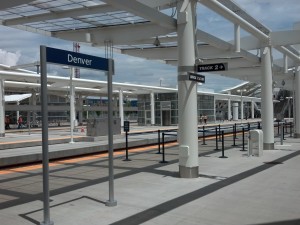With Denver on the FasTracks, Hoping the Twin Cities Aren’t Derailed
Last month Denver opened its long-awaited A Line train service connecting downtown and Denver International Airport. The twenty-three mile service takes thirty-seven minutes and costs nine dollars each way. The important fact that Minneapolis has had downtown to airport train service for 12 years notwithstanding, the opening of Denver’s A Line is symbolic of something much more. The A Line represents more than a decade of political and financial commitment in the Denver region (and the State of Colorado) to building transit infrastructure. Here in the Twin Cities, the Minnesota Legislature’s uncertainty about funding the Green Line extension (SWLRT) represents a potential long-term threat to the future viability and mobility of the entire state.
The A Line is but one piece of a significant, coordinated plan to expand transit service in the Denver region. It is the fruits of FasTracks, a tax increase approved in 2004 through a contentious but concerted effort by the Denver region to cooperate as a whole to improve mobility for all. One look at the FasTracks map shows an impressive display of transit expansion and regional coverage. Perhaps most impressive, the A Line is not the only transit line opening in Denver in 2016. Five, count them, FIVE, new transit lines are due to open this year.
Contrast this to the Twin Cities, where a single line may be cancelled in 2016 if the Minnesota Legislature doesn’t step up to fund the state’s share of the cost. To be fair, the Twin Cities has transit successes. The first legs of the Blue and Green Line exceeded ridership expectations, and development is occurring near train stations. Bus service is also good, and the Twin Cities has its own A Line, a rapid bus service set to open in June of this year. The problem is, the Twin Cities lags behind the Denvers of the world due to a lack of dedicated funding for transit improvements. Bus and rail improvements tend to be a series of one-off projects, built when the political stars align, but all too often also bus improvements get delayed. This is no way to make the region and state competitive in the long-term.
I applaud the efforts of Twin Cities regional business leaders and a few mayors for recent editorials in the Star Tribune in support of dedicated funding. However, two things jump out at me in the mayors’ editorial. First, the piece is pretty vague on specifics and doesn’t single out the importance of individual lines, particularly funding and building the Green Line extension (Southwest Corridor (SWLRT)). Second, the mayors of Minneapolis and St. Paul aren’t part of this particular call for more transit funding, and I can’t figure out why not. The collective call for more transit funding must be more universal.
In 2004, the year the Twin Cities first light rail line opened, the Denver region approved $4.7 billion for transit expansion. In 2016, five transit lines will open in Denver and the State of Minnesota may not come up with $130 million (3% of $4.7 billion) to fund its next signature transit project. An optimist will say 2016 is an inflection point for the future of transportation in the Twin Cities and Minnesota; this is our chance to fund future mobility in our region and state, if only our leadership is up to the task. A pessimist will say 2004 was the inflection point, and the current results in Denver are proof that the Twin Cities have fallen hopelessly behind. Let’s keep in mind that in 2003 Denver didn’t have a long-term transit funding solution, so I’d like to remain optimistic.
This was crossposted at streets.mn.
1 Comment »
RSS feed for comments on this post. TrackBack URI
Leave a comment
Line and paragraph breaks automatic, e-mail address never displayed, HTML allowed: <a href="" title=""> <abbr title=""> <acronym title=""> <b> <blockquote cite=""> <cite> <code> <del datetime=""> <em> <i> <q cite=""> <s> <strike> <strong>


[…] This was crossposted at Joe Urban. […]
Pingback by With Denver on the FasTracks, Hoping the Twin Cities Aren’t Derailed | streets.mn — May 10, 2016 @ 4:34 pm